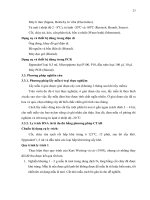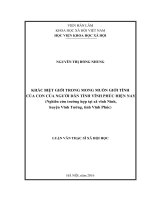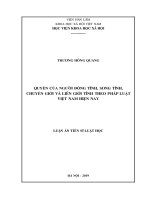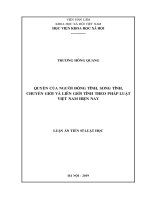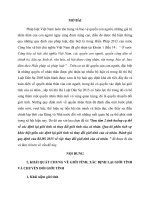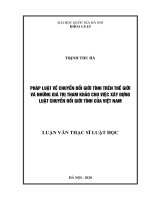Sự giao thoa giữa giai cấp và giới tính các hoạt động kinh tế của phụ nữ ở phía đông và phía tây amman
Bạn đang xem bản rút gọn của tài liệu. Xem và tải ngay bản đầy đủ của tài liệu tại đây (3.89 MB, 338 trang )
University of Warwick institutional repository: />A Thesis Submitted for the Degree of PhD at the University of Warwick
/>
This thesis is made available online and is protected by original copyright.
Please scroll down to view the document itself.
Please refer to the repository record for this item for information to help you to
cite it. Our policy information is available from the repository home page.
The Intersectionality of
Class and Gender
Women’s Economic Activities in East and
West Amman
By
Nof Nasser Eddin
A Thesis submitted in partial fulfilment of the requirements
For the degree of Doctor of Philosophy in Sociology
University of Warwick, Department of Sociology
February 2011
Abstract
This research is based on a comparative study between East and West
Amman women in terms of economic activity. Amman is a patriarchal society and
this research explains the prevalent patriarchal structures that influence women’s
economic activities and experiences and how these patriarchal structures operate
differently depending on class. This research adopts an intersectional approach to
gender and class to provide us with a more comprehensive understanding of
women’s experiences in relation to economic activity. The study sheds light on the
fact that class in Jordan is very much related to place of residence, and the
differences between East and West Amman are very influential in determining
women’s experiences. It is meant to explore the views and attitudes towards
women’s economic activities, and the different views between East and West
Amman, and between men and women. Moreover, this research explores the factors
that influence women’s economic activities and how these factors are different
amongst women themselves. This research also identifies the strategies adopted by
women to deal with patriarchy- resistance, negotiation and accommodation-and
how those strategies differ depending on class. The data for this research was
collected through interviews with 18 women, nine from East and nine from West
Amman, economically active and inactive. The research also made use of 164
questionnaires completed by both men and women from East and West Amman.
The questionnaire aimed to provide us with data showing class differences between
East and West Amman, and was also used to provide us with the attitudes and
views towards women’s and men’s economic activities.
[I]
Contents
Abstract………………………………………………………………..
I
Contents……………………………………………………………….
II
Acknowledgments……………………………………………………
V
Introduction……………………………………………………………
1
Thesis Organisation …………………………………………………..........
6
Chapter One: Contextualisation ……………………………………
11
1.1 Jordan: Amman Expansion………………………….………………….
13
1.2 Jordan and the Palestinians: Relations and Tensions ……………….
17
1.3 Jordan’s Economy: The Amman Division .……………………..........
24
1.4 Women’s Labour Force Participation in Jordan ………….………….
29
Conclusion……………………………………………………………………
35
Chapter Two: Literature Review…………………………………….
37
2.1 Women, Work and Economic Activity ‘from above’………………...
40
2.1.1 Women and the State………………………………………………………………..
42
2.1.2 Women and Islam……………………………………………………………………
47
2.1.3 Gender Dimensions of Globalisation ……………………………………………...
51
2.2 Women, Work, and Economic Activity ‘from Below’………………..
60
2.3 The Intersectionality of Class and Gender…………………………….
72
Conclusion…………………………………………………………………….
81
Chapter Three: Methodologies…………………………………........
83
3.1 Changing the Focus………………………………………......................
85
3.2 In the Field: Self, Power, Ethics……………………………..................
92
[II]
3.3 Research Methodology…………………………………………………..
100
3.3.1 Access Points and Sampling…………………………………….………………...
103
3.3.2 Combining Methods………………………………….……………………………...
114
3.3.3 Interviews …………………...........................................................................................
116
3.3.4 Self-Completion Questionnaire...…………………………………………………..
119
3.3.5 Data Analysis……………………………………………………………………….
120
Conclusion…………………………………………………………………….
122
Chapter Four: Attitudes and Views of Women and Men towards
Women’s Economic Activities…………………………….…………
124
4.1 Women’s Work vs. Men’s Work……………………………………….
129
4.1.1 Men: Heads of Households, Breadwinners………………………………………
136
4.1.2 Deprioritising Women’s Involvement in Income Generating Activities………
144
4.2 Women’s Economic Activities: Conditioned Choices…………….....
158
4.2.1 Balancing Work and the Household………………………………………………
160
4.2.2 It has to be Suitable! …………………………………………….................................
164
4.3 Women’s Work: Necessity and Accessory…………………………….
171
4.3.1 Necessity: East vs. West……………………………………………………………..
172
4.3.2 Additional Advantages……………………………………………………………...
175
Conclusion…………………………………………………………………….
179
Chapter Five: Women’s Experiences………………………………..
182
5.1 Education…………………………………………………………………
184
5.1.1 Accessing Education ..……………………………………………………………..
186
5.1.2 Education: Influence on Life Choices and Economic Activity………………...
199
5.2 Marriage: Before and After……………………………………………..
206
5.2.1 Different Approaches to Marriage…………………………………...…………...
208
5.2.2 The Marriage Experience………………………….....................................................
216
[III]
5.3 Social Control…………………………………………………………….
221
Conclusion……………………………………………………………………
231
Chapter Six: Women’s Economic Activities, Dreams, Hopes, and
Bargaining ……………………………………………………………..
234
6.1 Economic Activities…………………….………………………………..
238
6.1.1 Reasons behind Economic Activity or Inactivity…………………………………
241
6.1.2 Different Economic Activities…………….………………………………………...
256
6.2 Bargaining, Hopes and Dreams………………………………………...
262
6.2.1 Women’s Economic Activities: Bargain, ‘Independence,’ Escape………………
264
6.2.2 Hopes and Dreams…………………………………………………………………..
271
Conclusion…………………………………………………………………….
276
Chapter Seven: Conclusions…………………………………………. 279
Patriarchal Views and Attitudes……………………………………………. 281
Factors Influencing Women’s Economic Activities……………………….
286
Different Activities, Differential Work Status……………………………..
290
Bargaining with Patriarchy: Resistance, Negotiation and/or
Accommodation.............................................................................................
293
Potential Research and Research Limitations……………………………... 298
References………………………………………………………………
300
Appendix A: Interview Consent Paper……………………………..
320
Appendix B: Questionnaire Consent Paper………………………..
321
Appendix C: Interview Schedule……………………………………
322
Appendix D: Questionnaire………………………………………….
324
[IV]
Acknowledgments
Firstly, I would like to thank Birzeit University in Palestine for granting me
8000$ towards my tuition fees, and I would also like to thank Gender Economic
Research and Policy Analysis, CAWTAR, Centre of Arab Women for Research and
Training GERPA for awarding me 2550$ towards my field work in Jordan. I would
like to express my deep gratitude to my lovely supervisor Nickie Charles who has
supported me throughout this journey, and for listening to me talking about my
personal and academic life. I also would like to thank the staff at the University of
Warwick and particularly in the Sociology department. I would like to acknowledge
and thank my women interviewees and research participants for participating in this
research and I am sure that this piece of work would not have been written and
conducted without their help.
I would also like to thank my friends in Jordan for being there for me when I
needed someone to talk to about my research and share my obsession about this
topic over Shisha sessions and coffee. And also my friends in the UK for supporting
me and celebrating my success. Special thanks to Wafa’a and Tata Amani, for their
constant love and care in Jordan and for providing a homelike environment in the
field. Special thanks to my dearest friend Obaida who always listened to me,
challenged me and pushed me. Special thanks and deepest love to my wonderful
parents, Sara and Jalal, for believing and investing their time and effort in me and for
believing in the power of education and for giving me the opportunity to pursue my
education in the UK. Last but not least my best friends Nour and George who
tolerated my madness and my mood swings and who always gave me constant
assurance of my ability to carry on with my doctoral research. Finally I would like to
dedicate this thesis to two very special women, my grandmother Elham who passed
away during writing up my thesis and my mother Sara whom I love the most.
[V]
Introduction
This PhD thesis focuses on women’s economic activity in Jordan, and is based
on a comparison between women from East Amman and West Amman. The idea for
this research developed over time, starting as a comparison of economic activities of
Palestinian camp female refugees and Palestinian non-camp female refugees in
Amman. The initial idea of the research was triggered during my undergraduate
years in Jordan. I wanted to research Palestinian refugees in Jordan because I always
felt that they are a forgotten community and we rarely hear about them in
newspapers, on TV, and in the media. Additionally, during my four year stay in
Amman, the capital of Jordan, for my undergraduate degree, I learned about
differences between people and noticed how these differences become increasingly
apparent during my daily interactions and observations. For example, I could see
differences between peoples’ lifestyles, behaviours and the way they dress.
I wanted to compare camp and non-camp based Palestinian refugees, because
I noticed that there are differences between women in East and West Amman, and
most of the camps are located in East Amman. It was obvious that the refugee issue
still exists as a large number of Palestinians still live in refugee camps, where the
living conditions are extremely bad. Palestinian refugees are marginalised in the
media, and the experiences of women are often obscured. I also wanted to draw
attention to women’s differential experiences, based on certain factors such as class,
education, marital status, and age, which affect their involvement in economic
activities. Unfortunately, I did not succeed in studying the refugee community due
to the fact that the state of Jordan does not allow any research on the Palestinian
refugees living in camps to be carried out; how this became evident will be
explained more fully in chapter three. For this reason the focus of the research
changed from camp and non-camp based women refugees’ economic activities, to
women from East and West Amman’s economic activities, and the differences
between these. During my studies in Jordan, I noticed differences between people
1
from East and West Amman through my interactions with them. People from East
Amman are more conservative than people in the west of the city. For example, the
majority of women in East Amman wore the headscarf. When I drove in East
Amman, I noticed that I was the only woman driving a car in that part of the city.
Moreover, I noticed that people’s economic situation in West Amman is better than
in East Amman - people earn more money in West Amman and therefore their
quality of life is better than that of people from the east side. The streets in West
Amman are cleaner, and the houses more modern. This class division was also
obvious between students at the University of Jordan. Through making
acquaintances with people from my own and other Departments I started to notice
that each Department is labelled according to students’ life-style, clothing, or car
model. For example, students of education, social sciences, Islamic law and
humanities were labelled as ‘low class’, conservative, and ‘backward’. On the other
hand, people from the Business School, the Faculty of Arts and Design and
Departments of Engineering and Medicine were labelled as ‘high class’, ‘open’, and
‘immoral’. Moreover, the university campus was divided into ‘squares’, where
people used to socialise in the breaks between lectures. The squares were mostly full
of students with latest mobile models, wearing brand names, and designer clothing.
However, the rest of the students used to spend their time either in their
Departments or sitting on benches between Faculties and in squares. Students of
humanities, social sciences and education mainly came from rural areas, East
Amman, and refugee camps. Students studying other subjects came from wealthy
families living in West Amman, or from other countries. This division between East
and West triggered my curiosity to further investigate these differences. I went on to
drive around the city of Amman trying to explore and learn more about the diversity
of the city. As Khalifa and Krzysiek (2008: Para 2-3) write:
‘In West Amman you may feel like you are in a glass palace.
Fancy cars, villas with green gardens and swimming pools
exist behind the inaccessible walls: everything is clean, calm,
2
perfect and untouchable. Populated mainly by managers,
diplomats and private entrepreneurs, this part of the city
represents the highest class of Jordanian society. A few
kilometres east from of this kingdom of splendour, you enter a
different world. Contrary to the Western side, in East Amman
you can touch and feel almost everything. Poverty and misery,
people on the street, children playing football. Here everything
affects you, especially a smell. You can change a car, you can
dress differently< Living in the West of Amman is a privilege’
(Khalifa and Krzysiek, 2008: Para 2-3).
The focus of this research is women’s economic activity in Amman; it explores
why women seek work, or other income generating activities, and why upper and
upper middle class urban women have more choices than lower middle class and
working class urban women (Moghadam, 1993, El-Solh, 2003). Little has been done
on women’s economic activities in Jordan; this research is important because it fills a
gap and develops our understanding of the factors affecting women’s economic
activities. It also looks at the different experiences of women from the East side of
Amman and its West side. Furthermore, it examines the different economic activities
that women engage in depending on their class, and considers other factors such as
marital status, age and education. This research engages with the way in which
social, cultural, economic divisions and place of residence within one city, like
Amman, can determine a woman’s life course. It also explores how patriarchal
structures intersect with those of class, and the impact of this intersection on
different women’s experiences. This research investigates men’s and women’s
attitudes and perspectives towards women’s economic activities. It is important
because it discusses how class divisions and class as a system have large effects on
women’s lives. By class divisions, I not only mean differences in terms of financial
position, but also cultural class with respect to life styles, educational attainment,
economic activities, and social status. Both aspects of class, economic and cultural,
are under-researched in the Middle East, and culture is often taken to explain
3
women’s experiences. However, culture is influenced by class, and the cultural
aspect of class is very important to explain women’s different experiences.
The contribution of this research also relates to the fact that although women
in the Middle East might to some extent experience similar patriarchal gender
structures, those structures intersect with class making women’s experiences
different. In addition, it also explores the way that cultural and patriarchal gender
ideologies strongly affect the lives of women. This approach offers the chance to
examine patriarchy, particularly focusing on its impact on the economic activities of
women from diverse socioeconomic backgrounds. Therefore, unlike most research
on women in the Middle East, I explore the differences between women in an
attempt to avoid generalisations. Therefore, I do not look at women as a
homogenous group, which helps us to understand the reasons for women’s
differential experiences. Each Middle Eastern country constitutes a unique case, and
women in the Middle East, though sharing similar experiences of gender bias, are
not a homogenous group. Therefore, one cannot view women, even those coming
from the same country, as having the same experiences. Furthermore, it is important
to explore the different experiences lived by women who share the same culture but
at the same time do not share the same socio-economic situation, due to other
variables such as ethnicity, gender and class (Moghadam, 1993).
There have been numerous discussions on globalisation and economic reform
in the Middle East in terms of their effects on women’s status. Those same
arguments discuss patriarchy and its influence on women, but they fail to discuss
and link factors - such as culture, class, patriarchy, and gender - that lead women to
have differential positions (El-Solh, 2003, Moghadam, 1993, El-Kogali, 2002, MilesDoan, 1992). Moreover, those same scholars conclude that there are differences
between women and they are not a homogenous group, but they mostly fail to
explain the reason behind such differences. Islamic feminists, on the other hand,
always say that women are disadvantaged because of widespread misinterpretation
4
of Islamic verses and hadith1, tending to discuss Middle Eastern women’s
subordination (Sonbol, 2003). Furthermore, such studies tend to mention that
women coming from different socioeconomic backgrounds have different life
experiences, but this Islamic feminist paradigm does not explain why or how these
differences have been created in the first place. Unfortunately, many Islamic
feminists studying the Middle East fail to notice the existence of people with other
religions in the region, such as Christians and Baha’is. Islamic feminists, such as
Leila Ahmad, Riffat Hassan, Fatima Mernissi, and Ziba Mir-Hosseini ’see modern
liberal and egalitarian gender reformation of Islam as a requirement for the success
of a broader societal and political reform’ (Tohidi, 2003: 140). The focus of this
approach on Islam, however, overlooks cultural and class based subordination of
women.
Literature on women’s economic activity in the Middle East does not explain
why some women have been able to work, while others have not. Moreover, those
studies fail to understand the differences in terms of economic activity between
women of different classes, and that women from the same class also have different
experiences. The unanswered question remains: why do women from different
classes have differential experiences, if they allegedly share the same ‘Arab’ culture,
and if they are from the beginning subject to the same patriarchal rules? The
literature shows that there is space for research that explains the heterogeneity
amongst women in the Middle East. There is a lack of research on women and work
in the Middle East, and most studies on women and work do not adopt an
intersectional approach to understanding women’s experiences in relation to work.
Therefore, my research is designed to adopt an intersectional approach that not only
takes into consideration differences between women’s experiences, but also accounts
for differences between women’s agency, and views women as constructors of their
reality. This research will attempt to answer the following questions:
1
The word hadith stands for documented sayings of the prophet.
5
-
How do class and gender intersect to influence women’s economic activities
and life experiences?
-
What are men’s and women’s views of women’s economic activity? What
factors influence these views?
-
What factors affect women’s economic activity and are these different for
women in East and West Amman?
-
What economic activities are women in East and West Amman involved in?
How do these differ?
Thesis Organisation
This thesis is divided into seven main chapters. The first chapter of this thesis
deals with the research context. It provides a historical background on the
establishment of the state of Jordan after the fall of the Ottoman Empire, and traces
political changes in Jordan. The chapter explains how Amman, the capital of Jordan,
expanded because of the influx of Palestinian refugees following the 1948 ArabIsraeli war. This chapter also shows how the presence of Palestinians affected
Jordan’s stability, and provides a brief history of the 1970 civil war between the
Palestinians and the state of Jordan. It demonstrates that the Palestinian presence
influenced the economy in Jordan, in particular because most Palestinian refugees
were highly educated, and many of them worked in the Gulf oil producing countries
and sent remittances to their families in Jordan. It also explains how Jordan’s
dependence on remittances led to a recession, as a result of a decline in the demand
for labour in oil producing countries following the Gulf war. This chapter also
discusses women’s labour force participation in Jordan, in relation to the country’s
economy. It demonstrates that during the oil boom women were encouraged to
work outside their homes in Jordan because men were working abroad, while
following the recession and the return of the workers previously working in the Gulf
they were discouraged from this.
6
The second chapter positions this research within the existing literature on
women’s economic activity in the Middle East. It reviews the literature explaining
women’s position in the Middle East from both a macro-sociological and a microsociological approach. It demonstrates that scholars attempt to explain women’s
position from above and focus their analysis on the role of Islam and state in
women’s lives. It also includes discussions on the gender dimensions of
globalisation, and shows that, from a micro-sociological approach, previous
discussions focus on the Arab family unit. In this second chapter, I argue that
women are agents and not passive victims of patriarchy, and that taking this
approach is suitable because patriarchy as a social construct can be undermined,
challenged, resisted, bargained with and accommodated to by women. It also
discusses how the intersectional approach to women’s economic activities provides a
more comprehensive picture and explanation of women’s situation. I argue that
there are social categories, other than gender, which influence women’s economic
activities and life experiences, such as class, age, and ‘race’. Since this thesis adopts
an intersectional approach of class and gender to understand women’s different
experiences, the last section explains that my approach to class is informed by
cultural and economic factors.
The third chapter discusses how the focus of the research changed due to the
political sensitivity of the initial research topic, and shows how the research
questions also changed accordingly. It explains how the initial research was political
in nature, how in a police state, such as Jordan, conducting this type of research is
complicated. The chapter looks at my positionality in the field, and discusses ethical
and power issues presented during fieldwork with research participants, with the
state of Jordan and during the analysis of the material collected in the field. In this
chapter, I explain access points and sampling techniques used in this research, and
discuss the use of interviews and questionnaires as tools to collect data with which
7
to answer my research questions. In addition to this, I discuss the data analysis
process and the limitations of this research.
Chapter four is based on data collected from the questionnaires and
interviews, focusing on attitudes and views towards men’s and women’s work. It
shows that people view men’s economic activity as more important than women’s,
and explains the reasons behind these views and attitudes. It sheds light on the way
in which patriarchal structures influence these views, and how these views are
classed and gendered. It also highlights the factors which make it hard for women to
engage in income generating activities, and explains how the roles assigned to both
genders influence women’s involvement in income generating activities. The chapter
also shows that there are differences between women from East and West Amman
experiences, in relation to barriers to their economic activity. It also sheds light on
the intersectionality of gender and class, which influences what is considered to be
‘suitable’ economic activity and what is not. Furthermore, it demonstrates that in
some cases women’s economic activities become important and necessary as a result
of factors such as financial need, economic aspects of class, and marital status.
Finally, it shows that what makes women’s economic activities important differs
between East and West Amman.
Chapter five talks about women’s experiences in terms of education and
marriage, also considering the relevance of social control. This chapter suggests that
women’s economic activity and/or inactivity is influenced by educational
attainments, marriage, and social control over women’s lives. It shows that
educational attainments between women in East and West Amman differ because of
cultural and economic class. It illustrates that gender plays a major role in
determining women’s access to higher education, especially for women from East
Amman. It also explains that education influences women’s economic activities, as
women with higher education are more likely to be employed full-time or engaged
in regular economic activities.
8
Chapter five also demonstrates that marriage is a priority for East and West
Amman women; however, the expectations for the timing of marriage differ
between women from opposite sides of the city. The second section on marriage
reviews the different approaches to marriage, and explains the conduct of forced and
arranged marriages, showing that the approach to marriage is different in East and
West Amman. Furthermore, this chapter sheds light on the changes in women’s lives
after marriage, how their role becomes different, and shows how class is a major
determinant of the marriage experience itself. In addition to education and marriage,
women are placed under social control, which also influences their economic
activities. The final section focuses on patriarchal gender ideologies present which
make it hard for women to engage in income generating activities, and which
influence their freedom of movement and their decisions. Finally, the chapter
explains that women’s agency plays a major role in shaping their life experiences in
relation to marriage, education and social control, and that their agency differs
according to class.
Chapter six explores the different economic activities engaged in by women
from East and West Amman, and explores the factors that make some women
economically active, and others not. It demonstrates that household income is a
major determinant of women’s economic activities. This shows household income,
situation of the head of the household, and number of members in the household
determines whether a woman needs or wants to work or not. This chapter also
discusses how some working women believe that their economic activities,
particularly their financial contribution to their household, provide them with more
power; however, the chapter also reveals that what women see as power is in fact
space to negotiate structures of patriarchy. The final section of this chapter is
dedicated to giving a voice to women’s hopes and dreams. It shows that the hopes
and dreams of women differ depending on their cultural and economic class, as well
as their marital status. This clearly demonstrates that women’s experiences, hopes
9
and dreams are different, and also sheds light on the impact of class and gender
structures on women’s lives.
The final chapter discusses and reflects on the preceding chapters of the
thesis. It explains that the research questions were answered through the use of an
intersectional approach to class and gender, as well as helping us to better
understand women’s different experiences, and the way in which social categories
such as class, gender, marital status and sexuality intersect to create different life
experiences for women. Finally, the chapter discusses the contribution of this
research, and considers avenues for further research that could complement the
findings presented within this thesis.
10
Chapter One: Contextualisation
Introduction
With my observation of the differences between camp refugees living in East
Amman, and non-camp refugees living in West Amman, my interest grew and I
wanted to understand why both communities are so different. With the realisation
that I cannot legally conduct research on Palestinian refugees in Jordan, the focus of
this study shifted from the refugee community to the obvious geographical,
socioeconomic and cultural divisions within Amman, the capital of Jordan. For that
reason, this chapter traces the development and changes which have taken place in
Jordan from the beginning of the country’s establishment until today. Tracing the
history of Jordan provides us with broader knowledge about the socioeconomic
situation of Amman, and how the city itself expanded and became divided. As
Jordan has been through many socioeconomic and political changes, some of which
were intensified by the flow of Palestinian refugees into the country, it is important
to explain those changes. In particular, the Jordanian economy was affected by the
influx of refugees, the oil boom (1970s) and the recession phase (1980s). Those
changes not only influenced the Jordanian economy, but also influenced women’s
position in the labour force and their access to employment opportunities and
economic activities. For example, during the oil boom - a time when many Jordanian
men were working in the Gulf region - women were encouraged to work outside the
home, while later after the economic recession they were discouraged from seeking
employment outside the household.
As this research is based on a comparative study of women’s economic
activities in East and West Amman it is crucially important to show women’s
position in the labour force and their economic participation. Due to the lack of
separate statistical data on East and West Amman this chapter provides a
comparison between men and women’s labour force participation, and the
11
distribution of industries in Jordan generally and in Amman specifically. This
comparison will show how women are underrepresented in the labour force and are
excluded from certain occupations and industries.
Generally, women’s participation in the labour force in the Arab region is
low, as it averages 21 percent compared with around 40 percent in Sub-Saharan
Africa (El-Solh, 2003). ’Although labour force participation of women has been
rising, the increase is not as fast as one would expect< In fact the participation rate
for MENA2 women is the lowest for any region’ (Wahba, 2003: 26). El-Kogali (2002)
has argued that women are three times more likely to be unemployed than men in
the Arab Middle East. Thus, women usually stay unemployed for longer than men.
Jordan, generally, has the lowest rates of women’s labour force participation
compared to other Arab countries. Although Jordan has been a regional pioneer by
engaging in economic liberalisation, which has led to economic growth and an
expansion of its financial market (Awamleh, 2002, Sonbol, 2003), the country’s rate of
female economic participation is less than 12 percent (Guégnard et al., 2005).
To be able to understand labour force participation and the economic
activities of Jordanian women it is important to look at Jordan’s economic
development and the stages it went through in this. Therefore, an understanding of
Jordan’s economy, economic development and economic liberalisation, in addition
to its political changes, will contextualise the research in terms of the cultural and
economic class divisions that exist within Amman, and which lead to women having
different experiences of economic activity. Moreover, this chapter also shows that
class not only affects peoples’ experiences in relation to economic activity but also
that gender plays a detrimental role in shaping women’s experiences.
2
The Middle East and North Africa
12
1.1 Jordan: Amman Expansion
After the fall of the Ottoman Empire by the end of the First World War in
1918, the British Mandate of Palestine was established as stipulated in the SykesPicot agreement3 (see Figure 1.1 for map). The British Mandate of Palestine included
Palestine, which now constitutes Israel, the West Bank and the Gaza Strip, in
addition to Transjordan, which is now the Hashemite4 Kingdom of Jordan. So, both
Palestine and Transjordan were under British mandate of Palestine, which included
the east and the west sides of the Jordan River. However, Transjordan was under the
nominal rule of King Abdullah I, who remained the ruling Emir from 1921-1946; and
the territories were supervised by the British, in terms of foreign affairs and finance.
In 1921 Abdullah I chose Amman, located in the North West side of the country, to
be the centre of the Emirate of Transjordan’s political activities. At that time, Jordan
had three groups of inhabitants: nomadic Bedouins, villagers and people who were
living in urban areas in Jordan, including pre-war Palestinian merchants. It has been
estimated that in the 1920s the population of Jordan did not total more than 400,000
(Salibi, 1998). At the same time, Amman’s inhabitants were estimated to number
around 30,000. Amman’s first inhabitants were the Circassians, who migrated to
Jordan in the 1870s and resided in Amman. However, this structure has changed
after the influx of Palestinian refugees.
In 1946, Abdullah I established the Kingdom of Transjordan and proclaimed
himself as the King of Transjordan until 1949. Following the 1948 Arab-Israeli war in
the former area of Palestine Amman became the capital of the Hashemite Kingdom
of Jordan, when King Abdullah I also became king of the Hashemite Kingdom of
Jordan, and Jordan attained full-independence from the British. Amman at that time
The Sykes-Picot Agreement took place secretly in 1916 between France, Great Britain and Russia.
The agreement was based on controlling and dividing the Arab states between them, after the
expected fall of the Ottoman Empire.
4 The Hashemite Kingdom of Jordan derives its name from the Hashemite family, the rulers of the
kingdom who originate from the Hejaz region, in Saudi Arabia.
3
13
was considered a small city as it was not highly populated. However, it started to
grow when Palestinian refugees began to arrive and concentrate in Amman. The
1948 Arab-Israeli war, known as AlNakba in Arabic (meaning ‘The Disaster’), forced
approximately 750,000 Palestinian individuals to leave their houses, land and
property and find refuge in other countries, or other areas in former Palestine (Abu
Murad, 2004, Khalidi, 2005, UNHCR, 2000). Ever since then, these Palestinian
refugees have been struggling to attain their right to return, as political compromises
and Israel’s prevention of their return have so far deprived them from having their
demands realised (Akram, 2002, UNHCR, 2000, Ehrlich, 2004). Those 750,000
individuals have been hosted by neighbouring countries, such as Lebanon, Jordan,
Syria and Egypt, as well as neighbouring areas in Palestine itself, like the West Bank
and Gaza strip (Khawaja, 2003).
Figure 1.1: Map of the Sykes-Picot agreement
The United Nations Relief and Work Agency for Palestine Refugees
[UNRWA], established in 1949 by the UN General Assembly, has been the sole relief
14
and human development agency providing Palestinian refugees with basic
necessities such as education, healthcare, social services and emergency aid in the
neighbouring Gaza Strip, West Bank, Jordan, Lebanon and the Syrian Arab republic.
The UNRWA’s first response to Palestinian refugee flows was to provide them with
temporary tents, which due to their prolonged diaspora later had to be replaced with
more permanent shelters that eventually become permanent refugee camps.
However, the flow of Palestinian refugees did not stop in 1948 - on the contrary,
more refugees subsequently fled to neighbouring countries, as around 300,000
Palestinians were displaced in 1967 because of the Arab-Israeli war (Shiblak, 1996).
The number of Palestinian refugees increased from 914,000 in 1950 to 3.8
million refugees in 2001, and according to the UNRWA exceeded 4.3 million in 2006
(UNRWA, 2003, UNRWA, 2006). Jordan5 has the largest number of UNRWA
registered Palestinian refugees; it contained 1,930,703 registered refugees in June
2008, equalling 42% of the total registered Palestinian refugees. As I have previously
mentioned, the UNRWA originally provided Palestinian refugees with shelters,
which later became permanent refugee camps. In Jordan there are 10 refugee camps,
in: Talbieh, Zarqa, Marka, Souf, Jarash, Jabal Al-Hussein, Baqaa’, Amman new camp
‚Al-Wihdat‛, Husn Martyr Azmi Al-Mufti, and Irbid (see Figure 1.2 for a map of
refugee camps in Jordan). The largest Palestinian refugee camps are located in
Amman.
5
Jordan’s population in 2010 was estimated at 6,407,085
15
Figure (1.2) Map of Refugee Camps in Jordan
Following this, in 1991 a third wave of mass movement to Jordan occurred
following the Gulf War. Enormous numbers of Palestinians, and Jordanians, who
worked in the Gulf returned to Jordan, and were mostly forced into refugee camps.
Additionally, the first Gulf War also carried a wave of Iraqi refugees into Jordan.
Most recently, after 2003, following the so called war of liberation in Iraq, Iraqis
started fleeing to neighbouring countries; Jordan hosts a large number of Iraqis,
some of whom are registered as refugees while others are illegal immigrants without
official residence permits. Some estimate the number of registered Iraqis as being
500,000, while others say that there are now around one million Iraqis in Jordan
(Fafo, 2007). Aside from the refugee flows which have increased Amman’s
population, South Asian domestic workers and Egyptians also come in large
numbers to Jordan annually. So, one may say that since the establishment of the
Hashemite Kingdom of Jordan and until today, Amman has expanded continually.
16
1.2 Jordan and the Palestinians: Relations and Tensions
Amman is now the largest city in Jordan, containing the highest proportion of
Jordan’s population. There are 2,216,000 nationals in Amman; 1,139,400 men and
1,076,600 women (DOS, 2008)6. Many of those nationals are Jordanians of Palestinian
origin, as all of the refugees in Jordan were granted citizenship. UNRWA figures say
that there are 1,930,703 registered Palestinian refugees in Jordan, although the
majority of Palestinian refugees live in Amman. This means that around 87 percent
of Amman’s population are registered refugees, not including those who gave up
their refugee status, and who are unregistered. Furthermore, Amman contains a
large proportion of Iraqi refugees who fled Iraq in the first Gulf War in 1991 and
after the ‘War of Liberation’ in 2003.
During the British Mandate of Palestine, Palestine and Transjordan were both
governed by Britain, and Transjordan constituted 76 percent of the total land (see
Figure 1.3 for a map of the British Mandate of Palestine and Transjordan). Under the
British Mandate of Palestine many Jewish refugees sought refuge on the land of
Palestine, leading to tensions between Arab and the Jewish people in the region as
the Jewish refugees started claiming homeland on Palestinian land. Following those
claims the General Assembly of the United Nations adopted a resolution, which
recommended the termination of the British mandate and the division of the country
into two states: one Arab and one Jewish. Therefore, on May 14 1948, the state of
Israel announced its establishment, one day prior to the end of the British Mandate
(see Figure 1.4 for a map showing the partitioning of Palestine). Subsequently, King
Abdullah I annexed what is known now as the West Bank and East Jerusalem to the
Hashemite Kingdom of Jordan, including all Palestinians living in the West Bank
and Transjordanians.
6
Department of statistics
17
Figure 1.3: British Mandate of Palestine and Transjordan (1920-1948)
Figure 1.4: UN Partition Plan (1947)
The annexation came as a reaction to the establishment of a General Palestine
Government, as King Abdullah I wanted to create one entity which included the
West and the East Banks of the Jordan river, as one Jordanian country and nation. In
18
